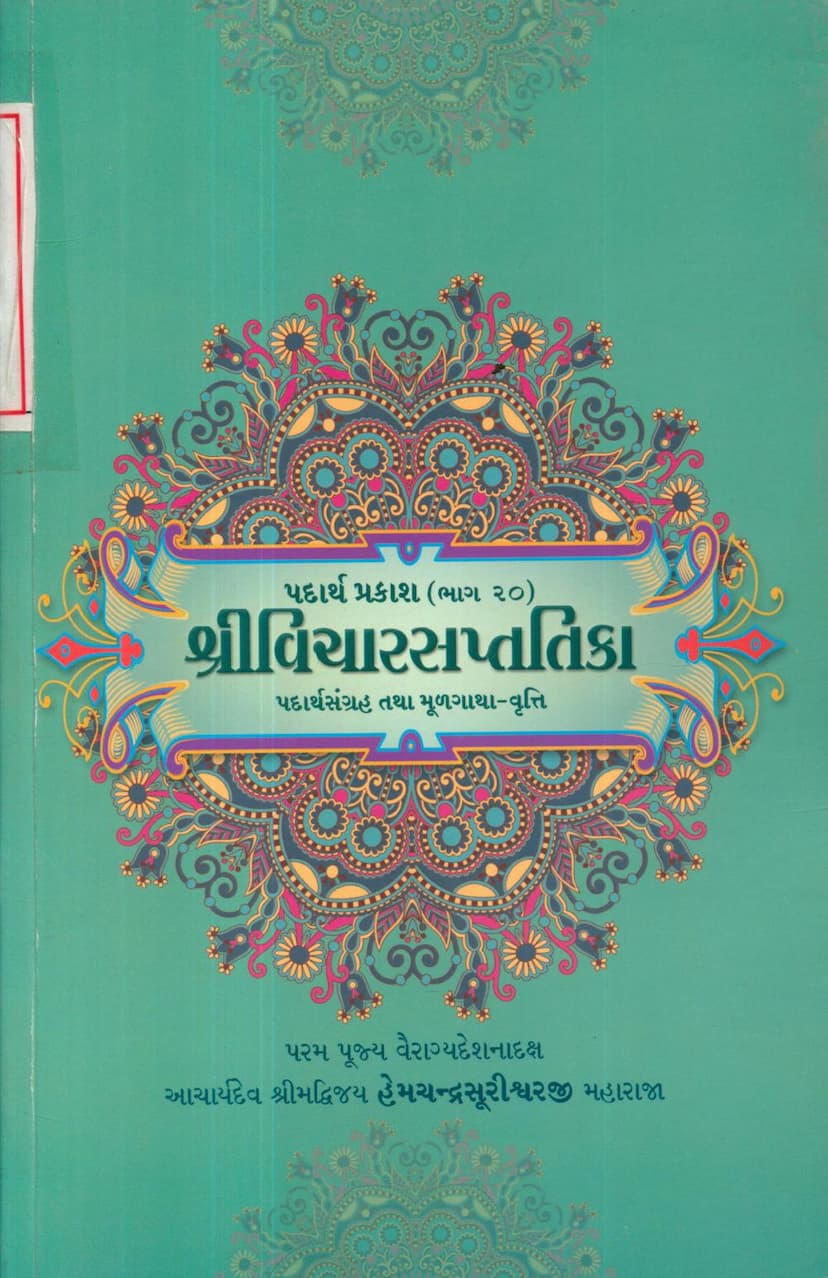Vichar Saptatika
Added to library: September 2, 2025

Summary
Here's a comprehensive summary of the provided Jain text, "Vichar Saptatika" by Acharya Shrimad Vijay Hemchandrasurishwarji, focusing on its content and purpose:
Book Title: Vichar Saptatika (Part 20 of Padartha Prakash series) Author: Acharya Shrimad Vijay Hemchandrasurishwarji (compiler and editor) Original Text Author: Shrimad Mahendrasuri (of Anchal Gaccha) Commentary Author: Shrimad Vinaykushalsuriji
Publisher: Sanghavi Ambalal Ratanchand Jain Dharmik Trust
Overall Purpose and Scope:
This book, "Vichar Saptatika," is presented as the 20th volume in the "Padartha Prakash" series. The core objective of this series, and specifically this volume, is to make complex Jain philosophical and cosmological concepts accessible to a wider audience, particularly through a simplified Gujarati explanation. "Vichar Saptatika" focuses on twelve specific "vichars" (considerations or topics) originally composed by Acharya Mahendrasuri and elaborated upon by Acharya Vinaykushali. The compilation and editing by Acharya Hemchandrasurishwarji aim to present these teachings in a clear, engaging, and understandable manner.
Key Features and Content:
-
Compilation and Editing: The work is a compilation and editing project overseen by the highly respected Acharya Shrimad Vijay Hemchandrasurishwarji, known for his ability to simplify complex subjects. The book utilizes the original Prakrit text of "Vichar Saptatika" by Mahendrasuri and the Sanskrit commentary by Vinaykushali.
-
The "Padartha Prakash" Series: This volume is part of a larger series that has already published detailed explanations of various fundamental Jain texts, including those on cosmology, karma, ethics, and scriptures like the Tattvartha Sutra.
-
The Twelve Vichars (Topics of Consideration): The central content of "Vichar Saptatika" is a detailed exploration of twelve specific topics, meticulously explained in this volume:
- Vichar 1: The Count of Eternal Jin Pratimas (Idols): This section delves into the number of eternally existing Jin images across different realms, presenting multiple scholarly opinions (Granthakar's view, Prosiddha view, and Chaitya Vandana Bhashya's view) with extensive numerical data.
- Vichar 2: The Measure of "Irriyavahi" (Movement) and "Michchhami Dukkadam" (Apology): This complex section details the number of living beings (classified by realm and sentience) and explains how the concept of "Irriyavahi Himsa" (violence through movement) relates to the extensive process of seeking forgiveness through "Michchhami Dukkadam," involving various factors like time, intent, and witnesses.
- Vichar 3: The Nature of Koti Shila: This topic describes a significant rock formation known as Koti Shila, believed to be a site where countless ascetics attained liberation. It also details an extraordinary feat of nine Vasudevas lifting and positioning this rock.
- Vichar 4: The Count of Eternal Jin Chaityas (Temples): Similar to the first topic, this section discusses the number of eternal Jin temples, again presenting different scholarly perspectives and detailed figures.
- Vichar 5: The Forms of Palaces (Prasadas) in Divine Abodes: This extensively describes the architecture and layout of divine palaces (vimanas) in celestial realms, detailing the arrangement of halls, lakes, and various types of temples within them.
- Vichar 6: The Spread of Sun's Rays in Six Directions: This explains the astronomical concept of the sun's rays and their reach across different directions and celestial bodies at various points in the year, considering factors like the sun's position and the curvature of the earth.
- Vichar 7: The Development of Perfections (Paryapti) in Different Bodies: This focuses on the biological and spiritual development of beings, explaining the six types of "paryapti" (perfections) related to sustenance, body formation, senses, vital breaths, speech, and mind, and how they manifest in different types of beings (one-sensed, multi-sensed, humans, gods, hell-dwellers).
- Vichar 8: The Nature of Krishna Rajis: This describes the dark bands or boundaries known as Krishna Rajis found in the Brahma-lok (fifth celestial realm), detailing their shape, size, and the celestial abodes situated within them. It also includes information about the lords of these abodes and their retinues.
- Vichar 9: The Circular Mountains: This section details three significant circular mountains: Manushottara, Kundala, and Ruchaka, describing their dimensions, locations, and the Jin temples situated atop them. It also elaborates on the celestial maidens (Dikumarikas) who reside on the Ruchaka mountain's various peaks.
- Vichar 10: The Eighth Nandishwar Dweep: This describes the eighth island continent, Nandishwar Dweep, renowned for its beauty and divine abodes. It details the key geographical features, including the Anjana mountains, the wells (vavadi), the gardens, and the Dadhimukha mountains, as well as the Jin temples located on these features.
- Vichar 11: The Religious Practices of Shravakas (Lay Disciples): This provides a comprehensive list of 37 religious duties and practices that Shravakas should undertake, covering aspects like faith, vows, rituals, charity, study, and community service.
- Vichar 12: The Fourteen Stages of Spiritual Progress (Gunasthanas): This offers a detailed analysis of the fourteen stages of spiritual evolution in Jainism, covering their duration (minimum and maximum), the possibility of dying or not dying in each stage, the transmission of spiritual progress to the next life, and the relative number of beings in each stage.
-
Inspirational Content: The book includes several short, insightful verses (dohas) and reflections that highlight core Jain ethical principles, such as detachment, non-violence, the impermanence of worldly possessions, the importance of virtuous conduct, and the power of the mind.
-
Scholarly Basis: The text explicitly references other foundational Jain scriptures and commentaries (e.g., Jivajivabhigama Sutra, Rajprashniya Upanga, Sthananga, Prajnapana, Pravaan Saaroddhara) to support its explanations and acknowledge different scholastic traditions.
-
Appreciation for Contributors: The publication acknowledges the efforts of typographers, printers, and title designers, as well as expresses gratitude to the gurus whose blessings made the compilation possible. It also humbly seeks forgiveness for any errors.
In essence, "Vichar Saptatika" serves as a vital bridge, translating complex Jain cosmological, philosophical, and ethical doctrines into an accessible format, enabling a deeper understanding and appreciation of Jain teachings for a broader audience.